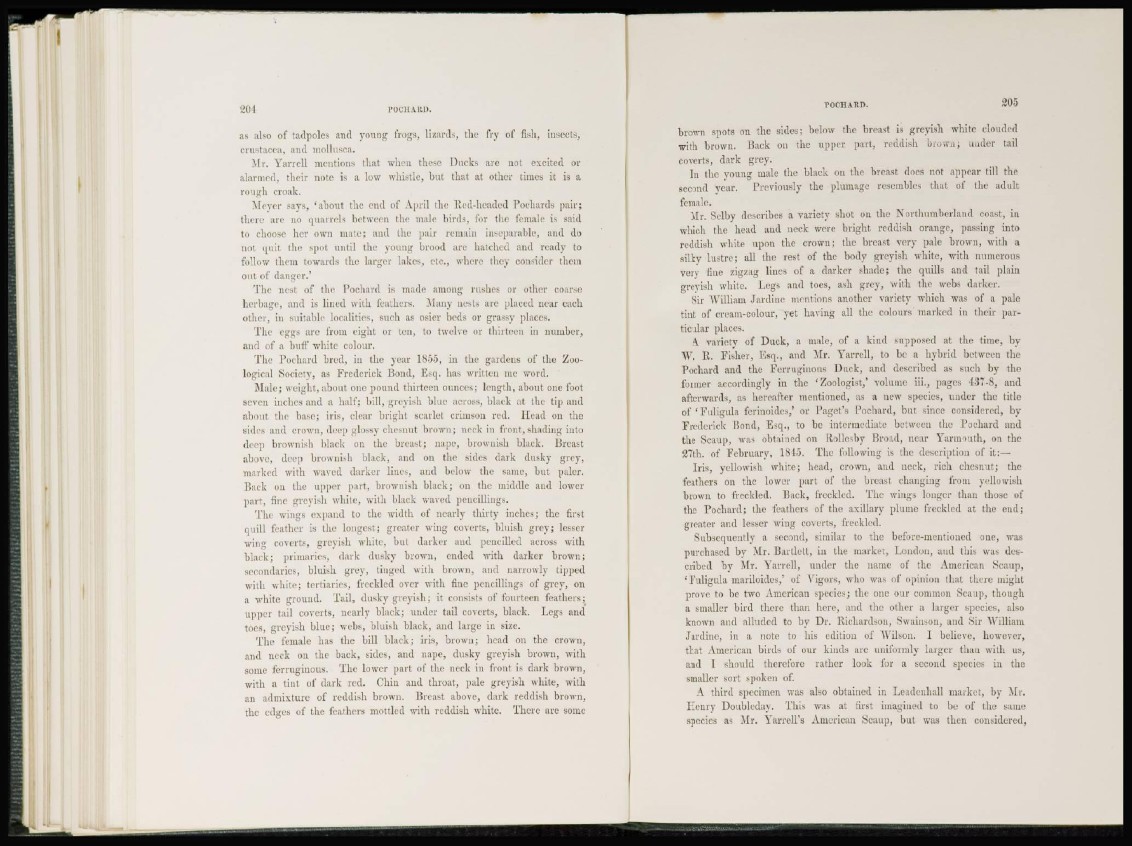
as also of tadpoles and young frogs, lizards, the fry of fish, insects,
Crustacea, and mollusca.
Mr. Yarrell mentions that when these Ducks are not excited or
alarmed, their note is a low whistle, but that at other times it is a
rough croak.
Meyer says, 'about the end of April the Red-headed Pochards pair;
there are no quarrels between the male birds, for the female is said
to choose her own mate; and the pair remain inseparable, and do
not quit the spot until the young brood are hatched and ready to
follow them towards the larger lakes, etc., where they consider then
out of danger.'
The nest of the Pochard is made among rushes or other coarse
herbage, and is lined with feathers. Many nests are placed near each
other, in suitable localities, such as osier beds or grassy places.
The eggs arc from eight or ten, to twelve or thirteen in number,
and of a buff wdiite colour.
The Pochard bred, in the year 1855, in the gardens of the Zoological
Society, as Frederick Bond, Esq. has written me word.
Male; weight, about one pound thirteen ounces; length, about one foot
seven inches and a half; bill, greyish blue across, black at the tip and
about the base; iris, clear bright scarlet crimson red. Head on the
sides and crown, deep glossy chesnut brown; neck in front, shading into
deep brownish black on the breast; nape, brownish black. Breast
above, dee]) brownish black, and on the sides dark dusky grey,
marked with waved darker lines, and below the same, but paler.
Back on the upper part, brownish black; on the middle and lower
part, fine greyish white1 , with black waved pencillings.
The wings expand to the width of nearly thirty inches; the first
quill feather is the longest; greater wing coverts, bluish grey; lesser
wing coverts, greyish white, but darker and pencilled across with
black; primaries, dark dusky brown, ended with darker brown;
secondaries, bluish grey, tinged with brown, and narrowly tipped
with wdiite; tcrtiarics, freckled over with fine pencillings of grey, on
a white ground. Tail, dusky greyish; it consists of fourteen feathers;
upper tail coverts, nearly black; under tail coverts, black. Legs and
toes, greyish blue; webs, bluish black, and large in size.
The female has the bill black; iris, brown; head on the crown,
and neck on the back, sides, and nape, dusky greyish brown, with
some ferruginous. The lower part of the neck in front is dark brown,
with a tint, of dark red. Chin and throat, pale greyish white, with
an admixture of reddish brown. Breast above, dark reddish brown,
the edges of the feathers mottled with reddish wdiite. There are some
brown spots on the sides: below the breast is greyish white clouded
with brown. Back on the upper part, reddish brown; under tail
coverts, dark grey.
I n the voung male the black on the breast does not appear till the
second yeaf. Previously the plumage resembles that of the adult
female.
Mr. Selby describes a variety shot on the Northumberland coast, in
which the head and neck were bright reddish orange, passing into
reddish white upon the crown; the breast very pale brown, with a
silkv lustre; all the rest of the body greyish white, with numerous
very fine zigzag lines of a darker shade; the quills and tail plain
greyish white. Legs and toes, ash grey, with the webs darker.
Sir William Jar dine mentions another variety which was of a pale
tint of cream-colour, yet having all the colours marked in their particular
places.
A variety of Duck, a male, of a kind supposed at the time, by
W. R. Fisher, Esq., and Mr. Yarrell, to be a hybrid between the
Pochard and the Ferruginous Duck, and described as such by the
former accordingly in the 'Zoologist/ volume iii., pages 437-8, and
afterwards, as hereafter mentioned, as a new species, under the title
of 'Fuligula ferine ides,' or Paget's Pochard, but since considered, by
Frederick Bond, Esq., to be intermediate between the Pochard and
the Scaup, was obtained on liollesby Broad, near Yarmouth, on the
27th. of February, 1815. The following is the description of it:—
Iris, yellowish white; head, crown, and neck, rich chesnut; the
feathers on the lower part of the breast changing from yellowish
brown to freckled. Back, freckled. The wings longer than those of
the Pochard; the feathers of the axillary plume freckled at the end;
greater and lesser wing coverts, freckled.
Subsequently a second, similar to the before-mentioned one, was
purchased by Mr. Bartlett, in the market, London, and this was described
by Mr. Yarrell, under the name of the American Scaup,
' F u l i g u l a mariloides,' of Vigors, who was of opinion that there might
prove to be two American species; the one our common Scaup, though
a smaller bird there than here, and the other a larger species, also
known and alluded to by Dr. Richardson, Swainson, and Sir William
J a r dine, in a note to his edition of Wilson. I believe, however,
that American birds of our kinds are uniformly larger than with us,
and 1 should therefore rather look for a second species in the
smaller sort spoken of.
A third specimen was also obtained in Leadcnhall market, by Mr.
Henry Doubleday. This was at first imagined to be of the same
species as Mr. YarrclFs American Scaup, but was then considered,